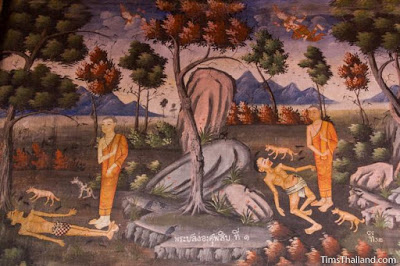by Patrice Priya Wagner

When teaching workshops on meditation, I’ve had students ask me what pose to use and usually I answer, “Pick a seated position that is comfortable for you, that you can hold for the entire time you want to meditate, and try not to fall asleep.” However, recently I learned of some textual-based evidence about the pose used by some ancient yogis for meditation that I could refer to when that question comes up again.
I’m fascinated by the history of yoga and am taking advantage of the current progress made by scholars who are translating and preserving ancient wisdom texts written in Sanskrit many centuries ago by yogis in India and other parts of South Asia. A few weeks ago, I started an online course on Raja Yoga offered by Yogic Studies and while I assumed that content from the readings and lectures would interest me, I expected most of it would be irrelevant to what I teach in present-day Hatha and meditation classes.
To my surprise, last week I was on the edge of my seat when I learned which pose some of the ancients used for meditation during the second millennium CE. To put this in context, in India during that era, yogic meditation was done in order to reach samadhi, a word with many translations including the no-mind state, bliss, and enlightenment. During that era, succeeding in Raja Yoga was the ultimate goal of any yoga practice and doing Hatha Yoga was not always necessary. Needless to say, yoga practice at that time was significantly different than it is in the 21st century.
In an ancient text called the Dattatatreyayogasastra, which is dated from about 1,200 CE, I learned that the pose we currently know as Corpse pose where you lie on your back in an anatomically neutral position, was taught in Laya Yoga as a position in which to practice “dissolution of the mind.” In Laya Yoga, this practice of dissolution of the mind was a meditation technique and one of the avenues used to reach samadhi, an easy one in fact, according to this ancient text. This was the first time I learned it was actually traditional for some yogis to meditate in a reclined position.
The Hathayogapradipika by Svatmarama, a more recent text from 1,450 CE, which is often referred to on questions about the origins of poses and practices we do today, explains Savasana as an asana to be used in the physical Hatha yoga practice. However, the earlier text the Dattatatreyayogasastra speaks of Savasana in the context of meditation practice only.
I was glad to learn some new information that is certainly relevant to what I teach these days. Now when a student asks me about what pose to use for meditation, I can explain what I learned from the Dattatatreyayogasastra or, if I’m short on time, I can just say, “You can meditate in a seated position or you could lie on your back in Corpse pose like the ancients did, but try not to fall asleep!”

Patrice Priya Wagner, RYT 500, C-IAYT, trained in Integral Yoga and has taught people with disabilities since 2008. She is the Managing Editor of the Accessible Yoga blog, is on the Board of Directors of Accessible Yoga, and assisted or co-presented in Accessible Yoga’s conferences held in New York City and San Francisco in 2017, and in Santa Barbara in 2015 and 2016. She currently offers classes for people with Multiple Sclerosis in Oakland, California, and brings to her teaching a focus on mindfulness and meditation to develop peace of mind inside and out of the studio.
Follow Yoga for Healthy Aging on Facebook ° To order Yoga for Healthy Aging: A Guide to Lifelong Well-Being, go to Amazon, Shambhala, Indie Bound or your local bookstore.


Thank you for this. Changes what many of us have learned over the years.
Fascinating. Thank you x